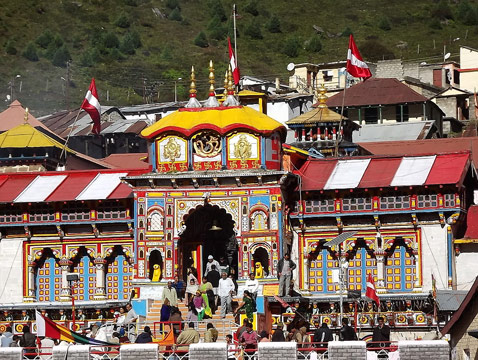Badrinarayan Temple
Click the 'Play' button to read out loud this webpage content
Introduction
Badrinath or Badrinarayan Temple remains as one of the most celebrated Vishnu temples in India. It is one of the Divya Desams, the holy abodes of Vishnu or Narayana, and is glorified by the Tamil Azhwar saints as Tiruvatariyacciramam or Thiruvatariyasramam in their hymns that form part of the Tamil literature. This temple is situated in the Garhwal hill tracks of the Himalayan mountain ranges, on the banks of the Alaknanda River in the town of Badrinath, in Uttarakhand state. This also forms part of the holy Char Dham, the four cardinal shrines of Lord Vishnu. The presiding deity here is Lord Badri Narayan, who is in a sitting posture. There is a belief that it was originally a Buddhist shrine, and was converted later into a Vishnu temple by Saint Adi Sankara. Nestled in the snow-clad mountains, the temple is open only during summer and remains closed during the winter months from October/ November.
Temple History and Legends

Saint Adi Shankara holds a significant position in the renaissance of Hinduism. Shankara, who established many temples and hermitages all over the country, had stayed in the town of Badrinath when he is said to have found the stone image of Lord Badrinath or Badrinarayan. He performed severe austerities there, and established the shrine for the Lord, subsequently. After some intervening periods, it was king Parmar who was instrumental in re-establishing this as a Hindu kingdom and restoring many shrines to their earlier glory. Also, the king of Garhwal moved the deity to the current shrine in the 16th century, and the temple underwent several renovations over the years.
According to a legend about this temple, once Lord Vishnu was meditating in the cold weather, and Goddess Lakshmi, his consort protected him in the form of the Badri tree, that is, Jujube or Indian date tree. Lord Vishnu was highly pleased by the devotion of Goddess Lakshmi and named this place as Badrika Ashram. Here it is interesting to note that once this place remained as a jujube forest as per some ancient scriptures, though the trees are extinct now.
According to another mythological story, sage Narada chastised Vishnu, when he saw Lakshmi massaging the Lord’s feet. This prompted Vishnu to meditate in this location for long. Further, according to Vishnu Puranam, Nar and Narayan, the sons of Dharma, were spreading the religion in the valley of Himalayas. When searching for a perfect place to establish their hermitage, they found this place, which had both hot and cold springs, and stayed in the spot where the temple is located now.
The Architecture of Badrinarayan Temple
This temple is about 3,133 m above sea level and looks like a Buddhist vihara. The temple structure consists of the Garbhagraha, the sanctum, the Darshan Mandap, the worship hall, and Sabha Mandap, the convention hall. The roof of the sanctum is conical-shaped and has a small cupola on top with a gold gilt roof cover. The porch is a stone structure and has several arched windows. The temple has a broad stairway leading to the main entrance, and then to the halls and shrines. The temple halls are supported by pillars and have intricate designs in them.
Lord Badrinarayan can be worshipped inside the sanctum seated in the Padmasana posture. He has four hands and holds the conch shell and wheel in two of them while resting his other hands on his lap. There are images for Goddess Lakshmi, Goddess Durga, and Lord Kubera, and also other shrines here. Narad Kund and Surya Kund are the two water bodies of this temple.
Temple Festivals
Mata Murti Ka Mela is a grad festival here that celebrates the descent of holy river Ganga on earth. The Badri Kedar festival is another celebration conducted during June in both the Badrinath and Kedarnath temples.
During the closure of the temple in winter, the image of the deity is transferred notionally to the Narasimha temple at Jyotirmath, about 64 kilometers away. The Badrinarayan temple is reopened once summer sets in, on the day of Akshaya Tritiya, in April or May.
Benefits of worshipping Lord Badrinarayan
There are quite a few devout in our land who consider it their religious duty to worship this Lord at least once in their lifetime. It is believed that his grace can bestow them with both material and spiritual blessings. Besides, this is one of the sacred places where people offer their prayers to their deceased ancestors in a Tarpan ceremony. The river of Alaknanda, which flows near the shrine, is considered extremely sacred, and it a belief that a dip in the river with piety can wash away all the sins.
How to reach Badrinarayan Temple
By Air
Jolly Grant Airport at Dehradun is the nearest airport, located at 317 kilometers from the shrine.
By Rail
Rishikesh, the nearest railway station is at a distance of about 300 kilometers.
By Road
Badrinath town is at a distance of about 300 kilometers from Rishikesh and is well connected by road. Apart from government buses, private transport services are also available to reach the temple, from many places.
If you wish to have customized spiritual tours or pilgrimages arranged in India for yourself or for a group of people, please contact Brindavan Mystic Services
Email ID: [email protected]
Toll free: 1800 102 9098